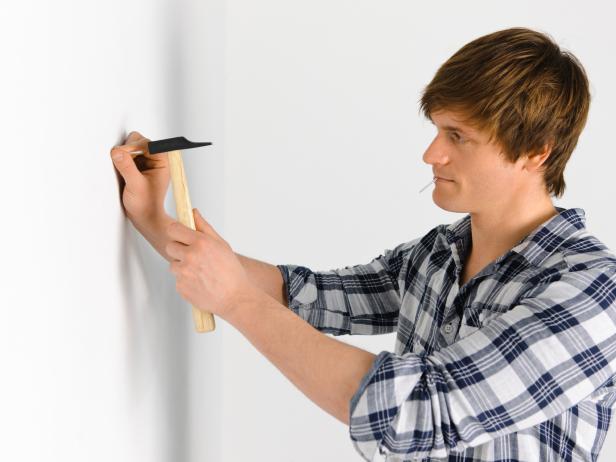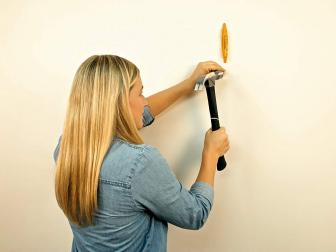How to Find Studs in a Wall Without Using a Stud Finder
Finding wall studs without a stud finder doesn't have to be a guessing game. If you're hanging something heavy on the wall, follow these best practices and pinpoint a stud with ease.

Hanging heavy items in your home starts with having the confidence and ability to locate wall studs hidden behind the drywall. Nails and screws can easily fall out of drywall if not properly anchored into a wall stud or by a drywall anchor. With a little know-how and an understanding of how to identify where the studs are in your room, anyone can hang items reliably and with ease.

©iStockphoto.com/WillSelarep
Having some background knowledge on how a wall is constructed helps when it comes time to find a wall stud:
- Walls are framed with a horizontal header at the top of the wall and a footer along the floor, so you can always guarantee to find a solid piece of wood along the top or bottom of your room.
- Vertical studs stand between the header and footer across the wall. They are usually placed 16 inches apart on all walls. It can vary in older homes, but rarely would you find studs more than 24 inches apart.
- Windows and doors are also framed by studs for support. Above wide windows and doors, you might even find a wide header board.
- Baseboards, window trim, door trim and crown molding are always nailed into studs.
- Drywall is also attached to studs, so you can count on finding studs at each corner of your room.
- Light switches and electrical outlets sit in boxes that are anchored to studs.
- Nominal 2x4 lumber has real measurements of 3-1/2 by 1-1/2 inches, but homes built before the 1950s might have been constructed using actual 2 x 4-inch boards.

Having a better understanding of construction gives you the knowledge to get really close to your targeted stud using nothing more than a tape measure. Rather than sporadically tap-tap-tapping your knuckle on your walls, measure first. Once you think you’re on point, you’re much more likely to hear the difference between a hollow space and a solid stud.
How to Find Wall Studs Without Using a Stud Finder
Increase your chances of finding a wall stud on the first trying the following:
1. Measure From Window or Door Trim
Window and door trim are anchored into studs. Sometimes, you can see dimples left by the nail where it is attached, but if not, choose a spot one inch from the edge of your window, and then measure out an additional 16 inches to find the next stud on the wall. You can go further, to 32 inches, or 48 inches away from the window and still have a high probability of hitting a stud.
2. Measure From a Corner
In all likelihood, there’s a wall stud in the corner of your room to which the drywall is attached. There may be some overlap where the drywall meets, but it’s usually pretty safe to assume that if you measure 16-inch increments in either direction from the corner, you’ll find a stud.
3. Do the Tap Test Around an Outlet or Switch
As we mentioned previously, the notorious “tap test” isn’t the most reliable way to pinpoint a stud, but it does come in handy when you check two very specific spots— to the left of a light switch, and to the right of a light switch. The electrical box is attached to a wall stud, so if you tap on either side of the wall plate it is easier to hear which side of the plate is hollow.
4. Discretely Predrill the Wall
Once you think you’re on point, one last way to confirm that you’re into a stud is to predrill a hole through the drywall with a narrow drill bit (think: 1/16-inch sized bit). You’ll be able to feel resistance if the bit hits a stud once it passes through the drywall. If you missed the stud, adjust your measurements and try again. Filling small error holes in the drywall is easier than filling big holes.
Can a Stud Finder Tool Make It Easier?
There’s no shame in relying on technology and tools if you’re trying to find a stud in your wall, but choose your product of choice carefully, as many aren’t worth the investment. Stud finders use either electronic sensors or magnets to detect studs in the wall. When choosing between popular stud finder products, keep in mind:
- Some multi-scanners are good for walls; others are good for both walls and ceilings.
- The best tools will allow you to adjust the sensor depth, so you can have a more accurate read through a deep wall. If you’re trying to detect through lathe and plaster, having a tool that can read four inches deep is important.
- Some products are better than others at detecting live wires, PVC pipes or non-magnetic metals, and it’s not uncommon for a tool to predict any of these other materials to be a stud.
- High-quality stud finders can be pricey.
When you’re using a stud finder, it’s always a good practice to validate the positioning of a stud by locating the studs on either side of your target. Using the logic explained above and measuring 16 inches in either direction from what the tool has identified to be a stud is the most fail-safe way to be sure your tool is providing a reliable read.
The Best Stud Finders of 2024 for Every Budget and Need
Protect your walls and wall art with these top-rated tools.





































